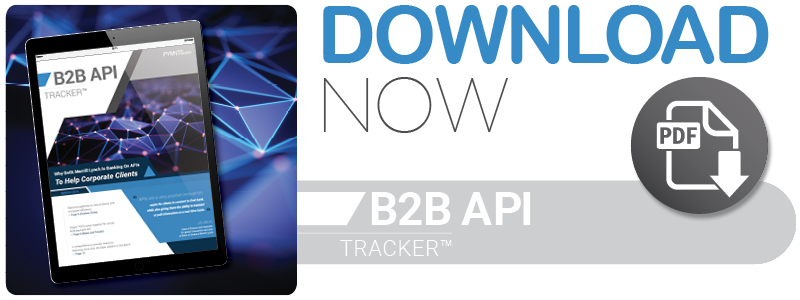Why BofA Merrill Lynch Is Banking On APIs To Help Corporate Clients
While FIs — big and small — are turning to APIs to boost their offerings, corporates still find it tough to get comfortable. What’s to blame? Aging infrastructure and a lack of standardization that’s complicating collaboration on both sides, says Hubert J.P. Jolly, Bank of America Merrill Lynch’s head of finance and channels. Jolly discusses the future of API adoption, and gives PYMNTS an inside look at the bank’s API plans in the latest B2B API Tracker.
In today’s digital age, FIs of all shapes and sizes are looking to work directly with partners and clients to publish new APIs. It’s a change that J.P. Jolly, head of finance and channels global transaction services at Bank of America Merrill Lynch (BofA Merrill), believes has been positive for the industry.
“I think for our industry, APIs are a very positive innovation,” Jolly said. “It just makes it so much easier for clients to connect to their bank, while also giving them the ability to transact or pull information on a real-time basis.”
He and his team at BofA Merrill are betting on API innovations to put an end to the payments challenges that have marred B2B players’ growth for years. In fact, the bank recently unveiled a series of new offerings to more easily connect with clients and banks.
In a recent interview with PYMNTS, Jolly explained BofA Merrill’s API-first strategy, including how it addresses payments’ most pressing pain points and creates opportunities to develop new products and services.
Working to provide enhanced experiences
BofA Merrill’s most recent API-related announcement was the launch of its API gateway.
According to Jolly, the solution is designed to give corporate clients improved access to banking information, speed up transaction times and improve transaction information tracking. It also works to achieve greater B2B payment efficiency by directly connecting treasury management and enterprise resource planning systems.
The gateway is not the firm’s only recent API-enabled effort to offer more efficient services to clients, however. In October 2017, BofA Merrill rolled out an API-based solution that provided a digital assistant for its CashPro platform. It was created to answer corporate clients’ demand for more information and data to aid in decision-making, Jolly explained.
The assistant uses APIs to automatically download and organize data from the portal, helping to cut down on the time it takes for clients to manually connect to and track data with CashPro. Much like the API gateway, the solution works to provide corporate clients with a more efficient banking experience.
“In the past, clients would have to manually download the same data every day and rearrange it so they could track in it whichever format they typically use,” Jolly said. “Now, they can just call upon those APIs and download the data in whatever format they want to use. That’s a better service experience for our clients.”
Debuting new products
While BofA Merrill’s gateway and digital assistant offerings aim to provide better options for existing processes, other APIs are working to create entirely new products or services. Jolly pointed to another recently debuted option, the bank’s enhanced Virtual Payables, which is designed to bring efficiency and speed to the previously slow, time-consuming B2B payment reconciliation process.
Enhance Virtual Payables enables businesses to connect directly with BofA Merrill’s virtual card system to create single-use account numbers in real time. It also gives suppliers access to account information and payment details without storing a card on file.
“This both offers a new product and enhances client experience through the APIs,” Jolly explained. “It gives them a way to better connect and engage with us or to transact with us.”
The solution allows BofA Merrill’s corporate clients to integrate a virtual card solution directly into their travel booking processes, too. Ultimately, it aims to give clients more flexibility and control when choosing how to connect and transact with the bank. So far, that control seems to be appealing, Jolly said.
“We’re seeing a lot of clients adopting this solution, because it’s a new product and one corporate clients have been asking about for a long time,” he added.
Boosting API adoption
While many clients are adopting the solution, not everyone is climbing aboard the bandwagon. According to Jolly, the slow adoption can be attributed, in part, to a lack of technological readiness. Many FIs still use legacy infrastructure and systems, making it difficult to connect to modern APIs or reducing the benefits the solutions can provide.
Perhaps more impactful, however, is the sheer number of API solutions currently available in the market. Every bank is racing to roll them out, and there is no standard system that can be adopted, which could cause confusion between companies.
Once the technology is standardized to a certain degree, Jolly expects APIs to become even more of a fixture for FIs of all shapes and sizes — and that should be welcome news to banks and their clients. Until there’s standardization across the industry, though, widespread adoption may remain difficult to achieve.
. . . . . . . . . . . . . . . .
About the Tracker
The B2B API Tracker™ serves as a monthly framework for the space, providing coverage of the most recent news and trends, along with a provider directory highlighting the key players contributing across the segments that comprise the B2B API ecosystem.
